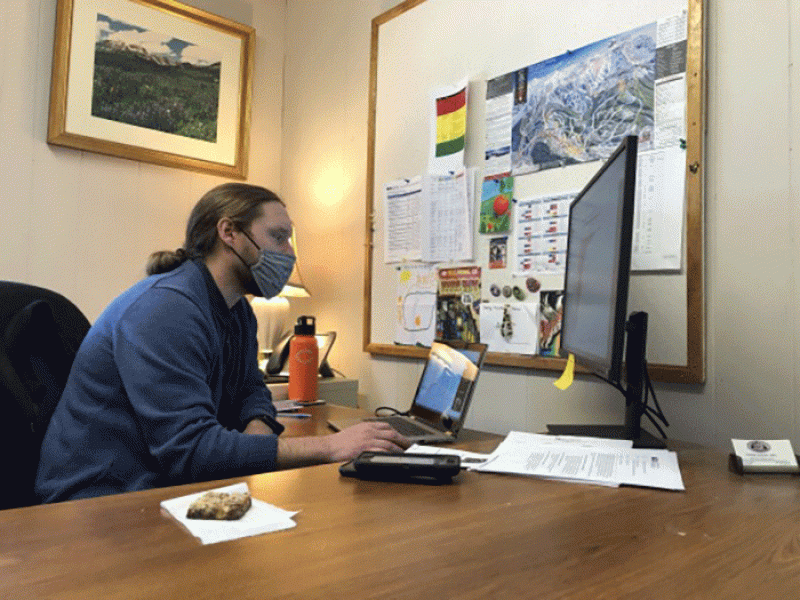
MPH grad believes we’ve turned corner on COVID
When Tanner Kingery became the county public health director in tiny Ouray County, Colo., in November 2019, he considered himself ready to tackle just about any issue.
After all, the 2015 Master of Public Health graduate had not only the training of a degree from a world-class university, he also carried with him the logistics knowledge of a veteran of the U.S. Navy. He moved to the southwestern Colorado, town of about 1,000 people shortly after graduation, working in different roles. But the world changed in March 2020, shortly after he moved into his current job.
“When I took over as the director, it was just, ‘OK, where's the budget at? Where's this program? Which of my employees is working on what?’ And then it quickly became, ‘OK—we need to stand up an Emergency Operations Center and build out an Incident Command System.
And we need to tackle this (COVID-19) pandemic with 100 percent of our effort,’’’ he said. “It's definitely been trial by fire—all the analogies you can think of, just jumping right in headfirst and trying to figure this thing out kind of on the fly.
“We're trying to build the ship as we sail it, or build the airplane as we fly it. But that's kind of what it's felt like. We’re flying by the seat of our pants a lot of the time.”
Kingery’s military background helped him set up the Emergency Operations Center and an operations hierarchy.
“And then my MPH background really helps when it comes to policy work and writing local orders and understanding core public health services and what needs to be prioritized when things have to fall by the wayside,” he said. “So some of that more technical training MPH wise was really helpful, too.”
Even in a town this small, Kingery faced the widescale problems much of the world did, such as making quick decisions on what businesses needed to close, how to stop community spread, and how to get the public informed.
“We started to put public health orders in place here locally,” the Central Illinois native said. “The state hadn't done anything yet, as far as a statewide mask mandate or any of the statewide public health orders that we've seen during the pandemic. That didn't exist really at the beginning. We were all trying to figure out what was going on.”
Kingery ended up writing more than 10 local public health orders, including restricting gathering sizes, and closing restaurants and retail stores. Without statewide backing, he faced local backlash.
“When there are directives coming down from the statewide level, you can just say, ‘Hey, this is what's coming down from the State. It provides us some protection locally,” he said.
“But when it’s my office issuing orders, that's all on us. We put it in a local mask mandate about two weeks before the state issued a statewide mask mandate. That took effect the day before the 4th of July holiday. That kicked off a lot of emails, phone calls, and upset people because that was when masking was quite controversial and was being associated with individual freedoms. Having my love of country and values toward freedom questioned was tough for me being a veteran. Having all that happen on the doorstep of Independence Day made it that much more difficult.”
Kingery was subject to name-calling from residents and business-owners of Ouray, situated about 5½ hours from Denver. July 4 is an important time for the mountain tourist town, which made his decisions even more scrutinized.
A year later, though, he’s glad he made the decision.
“We got through it,” he said. “And now I'm happy we got that local mask order in place because the county gets flooded during 4th of July.”
Kingery feels Ouray has turned the corner on COVID, thanks to what he calls a game-changer. Ouray County—which of which Ouray is the county seat¬—recently received 600 doses of the Johnson & Johnson vaccine. The county is almost 5,000 people, but many live in unincorporated parts of the county.
“We've kind of been hamstrung by … only getting about 100 doses a week at the beginning,” he said. “That was tough because … the expectations of the vaccine were so high. It was hard to meet all the public expectations when vaccine eligibility and vaccine availability aren’t aligned. So, we had to be very careful of who's getting the vaccine, and prioritize people, and filter people, and who gets what and when. And that was very, very stressful.”
But vaccine supply has picked up, and more than 2,500 vaccines have been administered as of mid-March. That makes Kingery optimistic that a return to pre-pandemic life—let’s not call it a return to normalcy—is near.
“I think we're going to see some sort of semblance to what things looked like pre-COVID probably this summer or early fall,” he said. “But I don't think things are ever going to look exactly like what they look like before COVID. I think people are still not going to want to go to the movie theaters and high-density settings like that. There's going to be populations and pockets of people who are still not going to want to be in a big crowd. It's not going to be exactly what life looked like. It's going to be kind of our new normal.”
